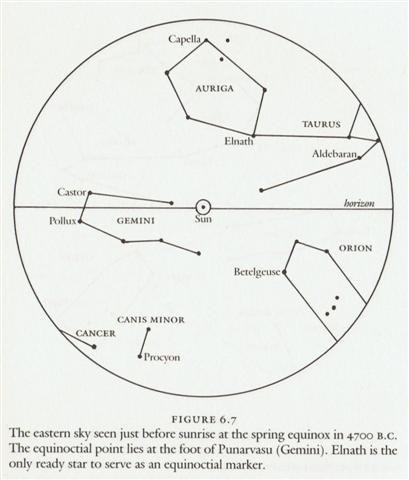78. Once again. The beginning of a Rigel year could have been where the Explorers sailed away from Hiva. There were 31 days in the Roman month of Martius, also before the Julian reform:
The Rogo figure in Ca3-25 could have been at the end of the River, at Cursa (β Eridani):
The sea voyage of the Explorers seems to have begun there. But evidently it did not go to Rigel, because its duration was 37 days: ... When the Explorers left their old homeland in Vaitu Nui 25 this was probably corresponding to the date "April 25 (115), and at the time of Gregory XIII Cursa would have risen with the Sun 41 - 4 = 37 days later, in °June 1 (152). When the Explorers reached Easter Island it was in Maro 1 ("June 1). We can therefore guess the sea-voyage of the Explorers - which took 37 days = Maro 1 (152) - Vaitu Nui 25 (115) - should be understood as alluding to the precessional distance to their old homeland (Hiva), i.e. from the time of Bharani to the time of Gregory XIII ... Maro means 'dry' and the Explorers reached dry land at the beginning of the month with this name. At the time of rongorongo the Bharani calendar dates had moved ahead with 41 days and 152 (Maro 1) + 41 = 193 (July 12):
However, at the time of Gregory XIII the calendar date would have been 4 days earlier, in °June 1 (152) + 37 = 189 ( °July 8):
... Space and time are a single, related concept in Runasimi [the language of the Inca people], represented by one word, pacha, which can also mean 'world' and 'universe'. The image of time familiar to Waman Puma was static and spatial: one could travel in time as one travels over earth - the structure, the geography, remaining unchanged. To him it does not matter that he shows Inka Wayna Qhapaq, who died in 1525, talking to Spaniards who did not arrive until 1532. Wayna Qhapaq was the last Inca to rule an undivided empire: he is therefore the archetype, and it must be he who asks the Spaniards. 'Do you eat gold?'
|
|||||||||||||||||||||||||||||||||||||||||||||||||||||||||||||||||||||||||||||||||||||||||||||||||||||||||||||||||||||||||||||||||||||||||||||||||||







